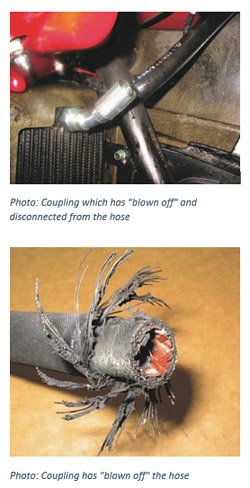
Posted to News on 24th Jan 2020, 10:45
Hose re-ending: the fallacies behind "˜saving a bit of money'
Hose re-ending is a very risky business. When you put a cost on downtime, maintenance and safety, how much money do you really save?

Quality is probably one of the most important metrics in the industrial world. When people pay for a product or service, they expect to get the best possible solution to their needs - not just in terms of cost, but also fitness for purpose, capabilities and, of course, safety.
Like so many things in life however, the expression "you only get what you pay for" rings true; with lower costs often equating to less exacting workmanship, increased wear, reduced operational life, or, indeed, all three. If you have money to burn, this is your choice, but when safety is a major part of the equation, you must consider if your short-term cost savings are really the most prudent - and ethical or even legal - course of action.
It is for this very reason - to help people make these sorts of decisions and to promote best practice - that standards exist to cover almost all facets of the industrial universe. The problem is, if these standards are not enforceable under law, you must rely on people applying them from a best-practice standpoint.
It is in these situations that trade bodies play a vital role, ensuring and supporting their members to adhere to good engineering practice - not only to bolster quality and the reputation of the industry, but also to ensure that any safety concerns are readily explained, understood and adhered to.
A case in point would be the British Fluid Power Distributor's Association's (BFPDA) Approved Hose Assemblies Scheme. Since its introduction in 1995, the scheme's "Q-Approved' logo has become a recognised symbol of quality, integrity and safety in the fluid power industry.
Comprising an accreditation process and resulting customer assurances, the scheme - developed by a panel of industry experts, including members of the BFPDA and BFPA - sets an industry-wide standard for the assembly, storage and supply of hydraulic hoses. As well as delivering best-practice guidelines, it also counters and addresses the health and safety issues associated with the risky practice of re-ending hoses. The core message behind these guidelines is that best practice recommends - very plainly - that you don't re-end hoses.
International standards
At the core of the scheme are the guidelines laid down by international standards. They state that all hose assembly practices must conform to the international recommendations within BS EN ISO 4413 and BS EN ISO 4414, and meet the guidelines. Both are Harmonised Standards of the Machinery Directive, which is written into legislation.
Clause 5.4.6.5.1 a) - within "BS EN ISO 4413 Hydraulic Fluid Power - General rules and safety requirements for systems and their components' states: "Hose assemblies shall be constructed from hoses that have NOT been previously used in operation as part of another hose assembly and that fulfil all performance and marking requirements given in appropriate standards." It is worth noting at this stage that in CEN and ISO parlance, the word "shall' is taken as "must comply' - it is non-negotiable. It is therefore quite clear that the international standard is intent to outlaw the re-ending of flexible hydraulic hoses. The scheme also adheres to BS EN ISO 4414, which mirrors this advice for pneumatic hoses.
Trade associations, industry experts and health and safety bodies all agree that you simply don't re-end hoses, the risks are too great; but the problem is that hose re-ending is still prevalent across much of the industry, with most people citing cost as the primary rationale.
Pirtek's Martyn Smart explains: "It is hard to convince people to hand over 200 for a new hose assembly, when they can get it re-ended for 50. With cost being such a defining factor, it's a real battle to convince them otherwise. I have seen 2,000 psi water jet hoses repaired with tape and a jubilee clip! Counter this with the fact that we have purchased and delivered over 4,000 BFPA books detailing the impact of fluid injection injuries and you can see that the message just isn't getting through - especially when bottom lines are a defining factor in the decision."
Andy Dickens, Operations Manager at Interpump Hydraulics (UK) Ltd., adds: "Companies are put under huge commercial pressures, so much so that re-ending is seen as the commercially attractive alternative." Backing up Martyn Smart, he adds: "We have seen hoses repaired with a bundle of gaffer tape. People don't seem to appreciate just how much pressure these systems are under. There is a massive amount of naivety, with people being blissfully unaware of the dangers of high-pressure fluid systems."
Smart adds: "A hose made from a "pick-and-mix' of third-party components simply cannot guarantee the tolerances necessary to ensure a quality hose assembly. Add to this the fact that you didn't know the operational history of the hose being re-ended and you have a potential recipe for disaster. No one will offer a guarantee or warranty on a re-end. We use matched components, all of which are tested by their manufacturers to meet tolerances, which for a swaged ferrule are +0mm/-0.2mm.
Lost tolerances
Dickens adds to this: "When you're re-ending, you're mixing and matching components. The products may appear to be the same, but there are differences. Our ferrules fit our hoses. If you use a third-party ferrule that's at the upper end of the tolerance band, it may not fit properly. I'm not saying that that ours are better - they just match our hoses. Anyone who's done a re-end has lost those tolerances. From where are they getting measurement information from? Whose data are they using?"
Smart explains: "There is an extreme amount of force trying to push these components apart. In its own right it is hard to put into words, but we have showcased it by setting up an assembly with a mis-manufactured hose, which is then put under 350 Bar of pressure. In this instance, it blew within 15 seconds and decimated a 3kg melon we had put next to it. We had to use a 2,000 frames per second camera to catch the failure and resulting impact. The hose end was measured at 600 ft. per second - similar to the muzzle velocity of a rifle."
The consensus from Smart, Dickens and the BFPA is that hydraulic hoses need to be addressed with the same level of importance and attention to detail that you would give to any precision engineered component. In addition to the simple cost of replacement, users must consider the cost of failure, from both a financial and a cost perspective.
Only by using hoses from suppliers accredited by the BFPDA's Approved Hose Assemblies Scheme, can users have the confidence that they have purchased an assembly that has undergone rigorous measurement and testing; assemblies that use matched components that are within defined tolerances and are backed by industry wide guidelines.
Smart concludes: "The more we educate people, the better and safer the industry will become. Hoses will get damaged in their everyday use. We need users to consider how and where they are used and then develop a proactive inspection and maintenance plan. This way, early failures can be more easily predicted and even have their causes designed out. Some protective systems are highly effective and are more palatable in cost terms versus replacement."
Dickens explains: "None of us seem to know who is doing this re-ending. But it is still going on. We will replace entire assemblies that have failed testing rather than elements of it, even though it costs us more. This is how committed we are to the safety of users, as should all of industry. We are then confident to offer warranties; which leads me onto an interesting final thought" re-ends do not come with any form of warranty or guarantee. Would you be prepared to purchase any other product without these in place?"
Learn more at www.hydraulichosesafety.co.uk.
Want the latest machine building news straight to your inbox? Become a MachineBuilding member for free today >>
British Fluid Power Association (BFPA)
Cheriton House
Cromwell Park
OX7 5SR
UNITED KINGDOM
+44 (0)1608 647900

















